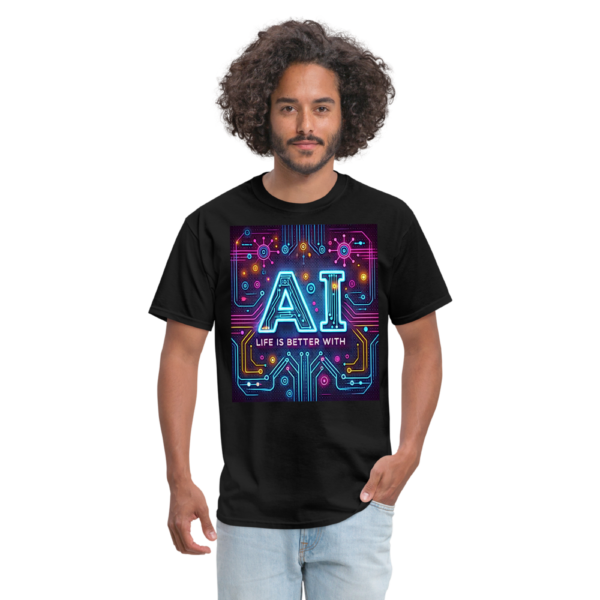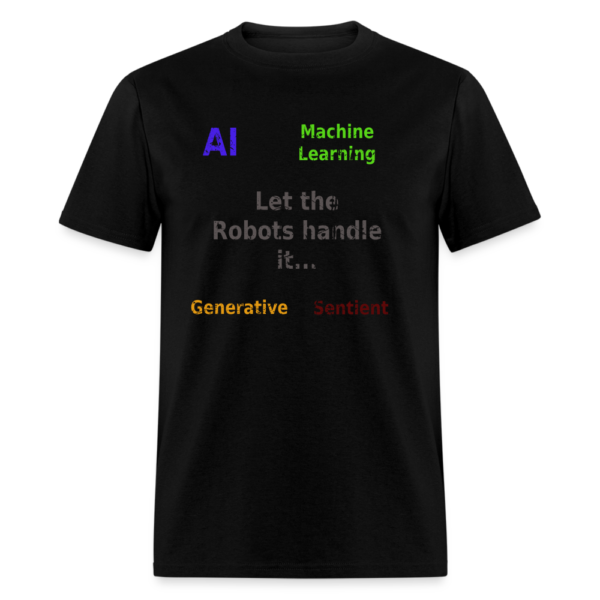Your cart is currently empty!
Tag: AI
🚀 Urban Hustle: How AI Supercharges Your Small Business on a Budget and Keeps Your Job Safe! 🤖
In the heart of the city, where every dollar counts and every minute matters, small businesses are always on the lookout for ways to get ahead without breaking the bank. As an urban entrepreneur with limited resources, you might be wondering if artificial intelligence (AI) is just another expensive trend designed for big corporations. The truth is, AI isn’t here to steal your job—it’s here to boost your productivity by ten times and help you work smarter, not harder.
AI: Your Budget-Friendly Business Partner
Running a small business in a bustling urban environment means juggling many tasks at once: managing finances, engaging customers on social media, keeping track of inventory, and much more. You don’t have the luxury of a massive team, so efficiency is everything. AI tools can help automate mundane and repetitive tasks, freeing up your time to focus on what really matters—growing your business.
Even with a shoestring budget, there are plenty of affordable AI solutions that are tailored to small businesses. For example, budgeting software with AI capabilities can analyze your spending habits and forecast future expenses. Chatbots on your website or social media platforms can handle common customer queries, ensuring your customers feel heard even when you’re busy. These smart tools don’t just save time; they save money.
How AI Enhances Productivity Without Replacing You
It’s important to understand that AI is not a competitor—it’s a collaborator. While AI can handle repetitive tasks, it still relies on human creativity, intuition, and judgment to truly shine. Here’s how AI is enhancing the urban small business landscape:
- Automating Everyday Tasks: From managing appointments and sending follow-up emails to processing orders, AI takes care of routine tasks that would otherwise eat into your day.
- Data-Driven Insights: AI tools analyze customer data, social media trends, and sales patterns. With these insights, you can make informed decisions that drive growth, all without needing to hire a full-time data analyst.
- Enhanced Customer Engagement: Using AI-driven chatbots and personalized email marketing, you can keep your customers engaged and happy. These tools help maintain relationships, even when you’re short on staff.
- Smart Inventory Management: For businesses with physical products, AI-powered inventory systems predict what items are likely to run out, reducing waste and ensuring you never miss a sale.
Imagine you run a small café in a busy urban neighborhood. With AI, you can track customer preferences, optimize your inventory to avoid food wastage, and schedule staff shifts based on predicted busy times. This means more satisfied customers and fewer unexpected costs—all while you focus on perfecting your latte art!
The Value of Human Skills in an AI-Enhanced World
Even as AI makes significant strides in automating routine tasks, the core of any successful business remains the human touch. Your creativity, problem-solving skills, and ability to connect with customers are irreplaceable. AI tools are designed to complement these qualities, not overshadow them.
For example, a chatbot might answer basic questions about your services, but it can’t build the personal rapport that comes from face-to-face interactions or phone calls. When a loyal customer needs a special order or wants to share feedback, your personal involvement makes all the difference. It’s this unique blend of technology and human empathy that sets your small business apart in a competitive urban market.
Upskilling on a Budget: Leveraging AI Without Breaking the Bank
The future is all about continuous learning, and for small business owners, upskilling is key to staying competitive. Here’s how you can integrate AI into your business without needing a large training budget:
- Online Courses and Webinars: Many free or low-cost online resources can teach you the basics of AI and its practical applications. Platforms like Coursera, Udemy, and YouTube offer valuable insights into using AI tools for small businesses.
- Local Workshops and Meetups: Look for community events or local business associations in your area. These gatherings often provide hands-on training and networking opportunities with other urban entrepreneurs.
- Learning by Doing: Start small by integrating one AI tool at a time into your workflow. Experiment with affordable or even free AI software to see how it fits into your business processes.
- Peer Collaboration: Join online forums and local groups where fellow small business owners share tips and success stories about using AI. This kind of collaboration can offer practical insights that you might not find in formal training programs.
By taking these steps, you can harness the power of AI to enhance your productivity without significant upfront costs. Upskilling isn’t just about learning new software—it’s about transforming your entire approach to work, making your business more resilient and adaptable in an ever-changing market.
Real-World Success: AI in Action for Urban Small Businesses
Across urban centers, small business owners are already reaping the benefits of AI. Here are a few real-world examples:
Local Cafés and Restaurants ☕🍴
Small cafés in the city are using AI to predict customer flow, optimize staff schedules, and manage inventory. By analyzing customer trends and weather patterns, these businesses can plan for busier days, ensuring they have enough staff and ingredients on hand without overspending.
Boutique Retailers 🛍️
Boutique shops in urban neighborhoods are leveraging AI-powered tools to personalize customer experiences. From suggesting products based on past purchases to managing social media ads, AI helps these retailers stand out in a crowded market, driving both online and in-store sales.
Freelance and Service Providers 🎨💼
Freelancers, graphic designers, and marketing consultants are using AI tools to streamline their workflows. From automating routine administrative tasks to generating creative ideas for campaigns, AI is a game-changer. These professionals can now spend more time on client work and creative projects, which directly impacts their bottom line.
Urban Fitness Studios 🏋️♂️
Fitness studios are using AI to manage class schedules, track member progress, and even offer personalized workout recommendations. This not only improves customer satisfaction but also helps small studios run efficiently on limited budgets.
Navigating the Urban Business Landscape with AI
For urban small businesses, every dollar and every minute matters. Here are some practical strategies to seamlessly integrate AI into your operations:
Start with What You Need
Begin by identifying the tasks that consume the most time without adding much value. Whether it’s scheduling social media posts or managing inventory, find an AI tool that fits that specific need. This targeted approach ensures you get the most bang for your buck.
Experiment and Adapt
Don’t be afraid to try out different tools and software. The beauty of AI is that many platforms offer trial versions or affordable plans for small businesses. Experimentation will help you understand what works best for your unique business model.
Partner with Local Tech Experts
Urban centers are hubs of innovation, and there are often local tech experts or startups willing to collaborate with small businesses. These partnerships can offer customized solutions that address your specific challenges without the hefty price tag of large-scale software solutions.
Stay Agile and Open to Change
The world of AI is evolving rapidly. As a small business owner, staying agile and open to new ideas is crucial. Regularly assess your operations and be ready to adopt new technologies that can further streamline your workflow and enhance your productivity.
Why AI Won’t Steal Your Job—It’s Here to Empower You
It’s natural to worry that AI might one day take over, especially in an era of rapid technological change. However, AI’s primary function is to augment your capabilities, not replace them. The skills that make your business unique—creativity, critical thinking, and emotional intelligence—are things AI can’t replicate.
In the urban small business world, these human qualities are your greatest assets. AI simply provides the tools to amplify those strengths, enabling you to do more with less. By embracing AI, you’re not giving up control; you’re taking command of your business’s future, ensuring that every task, big or small, is executed with precision and efficiency.
Overcoming the Challenges: A Real-World Perspective
Adopting AI in a small business setting isn’t without its challenges. Limited budgets, time constraints, and the learning curve can seem daunting. However, the key is to view these challenges as opportunities for growth. Each new tool you master, each process you optimize, builds a stronger foundation for your business.
Remember, every successful urban small business has faced hurdles along the way. The integration of AI is just another step on the path to innovation. By continuously learning and adapting, you ensure that your business remains competitive, resilient, and ready to seize new opportunities as they arise.
Let’s Build a Community of Urban Innovators
The future of urban small business is bright, and AI is a vital tool in that journey. Whether you’re a café owner, a boutique retailer, or a freelance creative, AI can help you unlock new levels of productivity and success. And the best part? You don’t have to spend a fortune to get started.
Let’s share our experiences and learn from each other. Have you tried integrating an AI tool into your business? What challenges did you face, and how did you overcome them? Drop your thoughts in the comments below and share this post with fellow urban entrepreneurs. Your insights could spark the next big breakthrough in our community.
Final Thoughts: Embrace the AI Revolution on a Budget
AI isn’t a luxury reserved for large corporations with deep pockets—it’s a practical, accessible tool that can transform your small business. By automating repetitive tasks, providing valuable insights, and enhancing customer engagement, AI allows you to focus on what truly matters: growing your business and staying true to your unique urban vision.
So, don’t let budget constraints or fear of the unknown hold you back. Embrace the power of AI, upskill where you can, and watch as your productivity soars to new heights. Your business, your community, and your future are waiting—take the first step today!
Life Is Better With AI Unisex Classic T-Shirt
$19.99Life Is Better With AI Unisex Classic T-Shirt. Celebrate the future of technology with the ‘Life Is Better With AI’ Unisex Classic T-Shirt! Comfortable, stylish, and perfect for AI enthusiasts, this shirt is a must-have for anyone who loves innovation and modern design.
-

Hungry and Humble Football Player Flapping Arms Touchdown Celebration Unisex Classic T-Shirt #philly
$19.99 Select options This product has multiple variants. The options may be chosen on the product page -

Africatown in Philly Phrase Unisex Classic T-Shirt
$13.99 Select options This product has multiple variants. The options may be chosen on the product page -

Vintage Funny Cat Selfie UFO Alien Invasion Unisex Classic T-Shirt
$13.99 Select options This product has multiple variants. The options may be chosen on the product page -

Vintage Philly Underdogs German Shepherds Unisex Classic T-Shirt
$9.99 Select options This product has multiple variants. The options may be chosen on the product page
————————————————
We use AI GPT Chatbots to help with our content and may get some things wrong.
————————————————-
🚀 Boost Your Productivity 10x: How AI Enhances Your Job Instead of Replacing It! 🤖
In today’s fast-paced digital world, many professionals worry about artificial intelligence (AI) and its impact on the workforce. The common narrative is that AI will eventually replace human jobs, leaving us without a purpose. However, the truth is much more exciting: AI is here to enhance our productivity, empower us to achieve more, and create new opportunities for skilled workers. In this post, we will explore how AI is transforming the workplace, why it will never fully replace the human element, and what steps you can take to harness its power for a tenfold boost in productivity.
The Real Story Behind AI and Job Security
There is a widespread misconception that AI will lead to massive job losses, but history shows us that technological advancements have consistently paved the way for new industries and roles. When computers and the internet emerged, many feared that human labor would become obsolete. Instead, these innovations opened up realms of creativity, communication, and efficiency that we now take for granted.
AI works in a similar fashion. It automates repetitive tasks such as data entry, scheduling, and simple customer inquiries, allowing us to focus on tasks that require creativity, critical thinking, and emotional intelligence. This shift not only enhances our productivity but also increases job satisfaction by enabling us to engage in more meaningful and strategic work.
How AI Supercharges Your Productivity
Imagine having a personal assistant that works around the clock, handling mundane tasks so you can concentrate on what truly matters. AI can be that assistant by:
- Automating Repetitive Tasks: AI tools can manage scheduling, send reminders, and even sort through large volumes of data. This frees up your time to focus on high-impact projects.
- Enhancing Decision Making: With the ability to analyze data in real time, AI provides insights that help you make informed decisions quickly and accurately.
- Improving Communication: AI-driven chatbots and virtual assistants streamline customer support and internal communications, ensuring that queries are handled promptly and efficiently.
- Customizing User Experiences: Whether you’re in marketing, retail, or healthcare, AI can tailor experiences to individual needs, improving customer satisfaction and loyalty.
For instance, if you work in digital marketing, AI-powered analytics tools can monitor social media trends and consumer behavior, giving you a competitive edge by suggesting the best times to post content or the most engaging topics to cover. In healthcare, AI algorithms help diagnose diseases faster, allowing medical professionals to focus on patient care and innovative treatment strategies.
The Irreplaceable Human Touch in the AI Era
Despite AI’s impressive capabilities, there are essential qualities that only humans possess. AI lacks the empathy, creativity, and moral judgment that we bring to our work. Consider the role of a customer service representative: while an AI chatbot can answer common questions, it cannot empathize with a frustrated customer or offer a personalized solution. It takes a human touch to build trust and resolve complex issues.
Furthermore, strategic decision-making often requires a nuanced understanding of context and human behavior—areas where AI still falls short. This is why the collaboration between human intelligence and AI technology is not just beneficial but necessary. We must learn to work alongside AI, using it as a tool to enhance our capabilities rather than viewing it as a competitor.
Upskilling: The Bridge to a Future-Proof Career
To truly benefit from AI, continuous learning and upskilling are essential. Embracing AI means not only adopting new tools but also acquiring new skills that allow us to leverage these tools effectively. Here are some steps to future-proof your career:
- Learn the Basics of AI: Familiarize yourself with AI concepts and how they apply to your industry. Many online courses and resources are available to help you get started.
- Enhance Your Data Literacy: Understanding data analysis and interpretation is critical. This skill will enable you to make sense of AI-generated insights and apply them to your work.
- Focus on Soft Skills: Skills such as critical thinking, creativity, and emotional intelligence remain invaluable. These are areas where AI cannot compete with human ingenuity.
- Engage in Continuous Learning: Industries are evolving rapidly, and staying updated through training and professional development ensures that you remain relevant in the workforce.
Organizations that invest in employee training and development not only boost their productivity but also foster a culture of innovation and adaptability. In this AI-enhanced workplace, human expertise will be more important than ever.
Real-World Applications: AI Across Industries
AI is already making significant strides in various sectors, proving that its role is to complement and augment human abilities. Here’s a look at how AI is transforming different industries:
Healthcare 🏥
In healthcare, AI assists in diagnosing diseases, predicting patient outcomes, and personalizing treatment plans. For example, AI algorithms can analyze medical images with remarkable accuracy, aiding radiologists in detecting early signs of illness. Yet, doctors provide the crucial interpretation of these results, ensuring that patient care remains holistic and compassionate.
Finance 💰
The finance sector benefits from AI through fraud detection, risk assessment, and customer service automation. AI systems can monitor transactions in real time, flagging suspicious activities that require human investigation. Financial advisors then use these insights to guide investment decisions and provide personalized advice to clients.
Education 🎓
In the realm of education, AI offers personalized learning experiences by adapting to individual student needs. AI-powered platforms can identify areas where students struggle and provide tailored resources to help them improve. However, the role of educators remains critical in mentoring, motivating, and guiding students through their learning journeys.
Retail and E-commerce 🛒
Retail businesses use AI to optimize inventory management, predict customer behavior, and enhance the shopping experience. Chatbots handle customer inquiries and assist in online purchases, but human employees provide the personal touch that builds brand loyalty. In a world where customers crave authentic interactions, the synergy of AI and human service is a winning combination.
Marketing and Advertising 📈
AI-driven analytics tools enable marketers to analyze vast amounts of data, predict trends, and craft targeted campaigns. Social media algorithms can determine the best times to post content, while sentiment analysis helps brands understand consumer emotions. Despite these capabilities, the creative strategies and innovative ideas that drive successful marketing campaigns still come from human minds.
The Future of Work: A Collaborative Vision
The future of work is not a battleground between AI and human workers; it is a collaborative ecosystem where both thrive. AI handles the routine and data-intensive tasks, while humans focus on creativity, strategy, and interpersonal relationships. This partnership has the potential to revolutionize industries and unlock unprecedented levels of productivity.
By embracing AI, companies can streamline their operations and foster a culture of innovation. This synergy leads to improved efficiency, higher job satisfaction, and the creation of new job roles that capitalize on the strengths of both AI and human talent. It’s a win-win scenario where technology acts as an enabler, empowering us to reach new heights in our professional lives.
Overcoming the Fear of the Unknown
Change often brings uncertainty, and the rapid advancement of AI can be intimidating. However, history has taught us that fear of new technology is natural, and adaptation is the key to overcoming it. Instead of worrying about job displacement, focus on how AI can transform your daily work routines, enhance your skills, and open doors to innovative career paths.
By staying informed about the latest AI developments and actively engaging in learning opportunities, you can position yourself as an indispensable asset in your organization. Embrace the transformative power of AI as a tool for growth rather than a threat to your livelihood.
Practical Steps to Integrate AI into Your Workflow
Here are some actionable steps you can take to integrate AI into your work and reap its benefits:
- Identify Repetitive Tasks: Evaluate your daily routines and pinpoint tasks that consume time but require little creative input. Explore AI tools that can automate these processes.
- Experiment with AI Tools: Start small by incorporating AI into one aspect of your work, whether it’s data analysis, customer communication, or content creation. Experimentation will build your confidence and competence.
- Collaborate with IT and Training Departments: If you work in a larger organization, seek support from your IT or training department. They can offer resources, workshops, and guidance to help you get started with AI.
- Stay Updated: The AI landscape is constantly evolving. Follow industry news, join professional groups, and participate in webinars to keep abreast of new tools and best practices.
- Network with Like-Minded Professionals: Engage with communities that share insights and experiences about AI integration. Learning from peers can provide practical tips and inspire innovative solutions.
Conclusion: Embrace the Future with Confidence
AI is not here to take your job; it is here to elevate your capabilities and make you 10x more productive. The technology is designed to handle routine tasks, provide insightful data analysis, and streamline operations, freeing you to focus on creativity, strategy, and the human elements that drive success. While AI automates many processes, the need for skilled professionals who can operate, oversee, and innovate with AI remains critical.
By upskilling and embracing continuous learning, you can ensure that you remain an integral part of this evolving workforce. Rather than fearing the changes AI brings, view them as opportunities to grow, innovate, and transform your career. The future is bright for those who adapt and leverage AI as a powerful tool in their professional arsenal.
Let’s keep this conversation going! Drop your thoughts in the comments below and share this post with colleagues and friends. Your insights and experiences can help others see the incredible potential of working alongside AI, creating a community of forward-thinking professionals ready to embrace the future.
Life Is Better With AI Unisex Classic T-Shirt
$19.99Life Is Better With AI Unisex Classic T-Shirt. Celebrate the future of technology with the ‘Life Is Better With AI’ Unisex Classic T-Shirt! Comfortable, stylish, and perfect for AI enthusiasts, this shirt is a must-have for anyone who loves innovation and modern design.
-

Hungry and Humble Football Player Flapping Arms Touchdown Celebration Unisex Classic T-Shirt #philly
$19.99 Select options This product has multiple variants. The options may be chosen on the product page -

Africatown in Philly Phrase Unisex Classic T-Shirt
$13.99 Select options This product has multiple variants. The options may be chosen on the product page -

Vintage Funny Cat Selfie UFO Alien Invasion Unisex Classic T-Shirt
$13.99 Select options This product has multiple variants. The options may be chosen on the product page -

Vintage Philly Underdogs German Shepherds Unisex Classic T-Shirt
$9.99 Select options This product has multiple variants. The options may be chosen on the product page
————————————————
We use AI GPT Chatbots to help with our content and may get some things wrong.
————————————————-
The Creation of the XML File: Revolutionizing Data Exchange in the Digital Age
The Extensible Markup Language (XML) file has been a cornerstone of modern technology, quietly shaping how we interact with data online and offline. While the concept of XML might seem straightforward today, its creation was a groundbreaking innovation that laid the foundation for many of the technologies we rely on daily. Let’s dive into the origins of XML, its uses, and how it has transformed technology, paving the way for advancements that continue to shape the future.
A Brief History: Who Created XML?
The XML file format was developed by the World Wide Web Consortium (W3C) in the late 1990s, spearheaded by Jon Bosak. Often referred to as the “Father of XML,” Bosak led a dedicated team of experts to create a language that would simplify data sharing across different systems and platforms. The goal was to address the limitations of existing markup languages, such as SGML (Standard Generalized Markup Language), and create a more flexible, lightweight, and universally compatible solution.
Jon Bosak envisioned XML as a way to make data both human-readable and machine-readable. His leadership and vision helped shape XML into a standard that has since become indispensable in the tech world. Though Bosak’s name may not be as well-known as some tech icons, his contributions have had a profound and lasting impact on the digital landscape.
What is XML Used For?
XML is a markup language designed to store and transport data. Unlike HTML, which is focused on displaying data, XML is all about structuring information in a way that makes it easy to share, process, and store. Here are some key uses of XML:
- Web Development: XML forms the backbone of many web technologies, enabling data exchange between servers and clients.
- APIs and Web Services: Many APIs rely on XML to format requests and responses, making it easier for different systems to communicate.
- Document Storage: XML is often used to store structured documents, such as configuration files, technical manuals, and even eBooks.
- Data Interchange: Industries like healthcare, finance, and e-commerce use XML to standardize data exchange.
- Multimedia: Formats like SVG (Scalable Vector Graphics) and X3D (3D graphics) are XML-based, showing its versatility in various applications.
The Innovation Behind XML
The true brilliance of XML lies in its simplicity and adaptability. By defining a set of rules for encoding documents in a format that is both human-readable and machine-readable, XML has become a universal standard for data exchange. Here are some of the key innovations that XML brought to the table:
- Platform Independence: XML can be used on any platform, making it a universal solution for data sharing.
- Customizability: Developers can create their own tags to suit specific needs, giving them the flexibility to structure data in virtually any way.
- Validation: XML supports schemas and document type definitions (DTDs), ensuring data consistency and accuracy.
- Readability: Unlike binary formats, XML is text-based, which makes it easier to debug and maintain.
- Extensibility: XML’s design allows it to integrate seamlessly with other technologies and evolve alongside them.
How XML Changed Technology
XML’s introduction revolutionized the way data is handled and exchanged. Before XML, data sharing between systems often required complex, proprietary solutions. XML simplified this by providing a universal framework, leading to several major technological advancements:
- E-Commerce Boom: XML enabled seamless communication between e-commerce platforms, payment gateways, and inventory systems, accelerating the growth of online shopping.
- Cloud Computing: Many cloud-based services rely on XML to manage and exchange data between distributed systems.
- Interoperability: XML’s standardization made it easier for different technologies and platforms to work together, fostering innovation.
- Content Management: XML laid the groundwork for content management systems (CMS) by simplifying how data is stored and retrieved.
- Big Data and Analytics: XML’s structured format made it an essential tool for managing and analyzing large datasets.
XML in the Future: A Lasting Legacy
While newer technologies like JSON (JavaScript Object Notation) have gained popularity, XML remains relevant and widely used. Its robustness, versatility, and well-established standards ensure its continued importance in various fields. Here are some ways XML is poised to impact the future:
- AI and Machine Learning: XML’s structured format is ideal for training datasets and integrating AI systems with existing technologies.
- IoT (Internet of Things): XML can help standardize data exchange between IoT devices, ensuring compatibility and scalability.
- Digital Preservation: As a human-readable format, XML is ideal for archiving digital content, ensuring accessibility for future generations.
- Blockchain: XML can play a role in enhancing blockchain applications by standardizing data formats and enabling better interoperability.
Why XML Matters More Than Ever
Despite being over two decades old, XML continues to be a vital part of the technological ecosystem. Its adaptability and widespread adoption have ensured its place as a foundational technology. As the digital world becomes more interconnected, XML’s ability to facilitate seamless data exchange will only become more valuable.
Join the Conversation
What are your thoughts on XML and its impact on technology? How do you see it evolving in the future? We’d love to hear your insights and experiences. Share your thoughts in the comments below, and don’t forget to share this article with others who might find it interesting!
Vintage I Love Tech Unisex Classic T-Shirt
$13.99“Geek out in style with the Vintage ‘I Love Tech’ T-Shirt! Perfect for tech lovers, gadget enthusiasts, and anyone who’d rather be coding—show off your love for all things techy!”
-

Hungry and Humble Football Player Flapping Arms Touchdown Celebration Unisex Classic T-Shirt #philly
$19.99 Select options This product has multiple variants. The options may be chosen on the product page -

Africatown in Philly Phrase Unisex Classic T-Shirt
$13.99 Select options This product has multiple variants. The options may be chosen on the product page -

Vintage Funny Cat Selfie UFO Alien Invasion Unisex Classic T-Shirt
$13.99 Select options This product has multiple variants. The options may be chosen on the product page -

Vintage Philly Underdogs German Shepherds Unisex Classic T-Shirt
$9.99 Select options This product has multiple variants. The options may be chosen on the product page
————————————————
We use AI GPT Chatbots to help with our content and may get some things wrong.
————————————————-
ChatGPT is Down, Down
If like us you jumped on chatgpt this evening to get some work done, we have bad news. As of 8:50 pm EST, Chatgpt.com has a rather sad message for its users:
"ChatGPT is currently unavailable.
Status: Identified - We have identified the issue and are working to roll out a fix."Add this to the full waiting list for Sora and you have a very quiet day for OpenAI. Stay tuned here for any updates.
Vintage Let the robots handle it – ai ml generative sentient Unisex Classic T-Shirt
$13.99Vintage Let the robots handle it – ai ml generative sentient Unisex Classic T-Shirt. Kick back and relax with the Vintage ‘Let the Robots Handle It’ T-Shirt! Perfect for AI enthusiasts and tech lovers who know the future is automated—because why do it yourself when a robot can do it better?
-

Hungry and Humble Football Player Flapping Arms Touchdown Celebration Unisex Classic T-Shirt #philly
$19.99 Select options This product has multiple variants. The options may be chosen on the product page -

Africatown in Philly Phrase Unisex Classic T-Shirt
$13.99 Select options This product has multiple variants. The options may be chosen on the product page -

Vintage Funny Cat Selfie UFO Alien Invasion Unisex Classic T-Shirt
$13.99 Select options This product has multiple variants. The options may be chosen on the product page -

Vintage Philly Underdogs German Shepherds Unisex Classic T-Shirt
$9.99 Select options This product has multiple variants. The options may be chosen on the product page
————————————————
We use AI GPT Chatbots to help with our content and may get some things wrong.
————————————————-
-
Is Tesla Really Leading the 4th Industrial Revolution, or Is It Just Hype?
The concept of the “4th Industrial Revolution” (4IR) has been gaining traction in recent years, with technological advancements leading the charge in reshaping industries, economies, and everyday life. Tesla, with its innovation-driven approach and bold vision for the future, has become central to this conversation, as noted by tech analyst Dan Ives. He remarked, “I’ve covered tech for almost 25 years – What I saw yesterday in LA, I think was a game-changer. This is the new chapter, the new book for Tesla, $TSLA – Tesla is front and center of the 4th Industrial Revolution.” But what exactly is the 4th Industrial Revolution, and will Tesla or companies like it provide the necessary spark for it?
Defining the 4th Industrial Revolution
The 4th Industrial Revolution, also known as Industry 4.0, refers to the next wave of transformation in how industries operate and societies function, driven primarily by rapid technological advancement. Unlike the first three industrial revolutions, which were characterized by mechanization (steam power), electrification, and digitalization (computers and the internet), the 4th Industrial Revolution represents a fusion of physical, digital, and biological systems.
The foundation of 4IR lies in technologies such as artificial intelligence (AI), machine learning, robotics, the Internet of Things (IoT), quantum computing, biotechnology, and advanced materials like graphene. These technologies are not just improving productivity or making incremental changes—they are fundamentally altering how entire industries operate, creating new opportunities and challenges.
Tesla: The Catalyst for Industry 4.0?
Dan Ives’ statement about Tesla being front and center in this revolution points to the company’s multifaceted innovations that are reshaping the transportation, energy, and manufacturing sectors. Tesla’s potential to act as a catalyst for the 4th Industrial Revolution can be understood through a few key lenses:
1. Electric Vehicles (EVs) and Sustainable Energy
Tesla’s electric vehicles have disrupted the traditional automobile industry, which had been reliant on internal combustion engines for over a century. The widespread adoption of EVs signals a shift towards cleaner, sustainable forms of transportation, aligning with global goals to reduce carbon emissions and combat climate change. By integrating renewable energy solutions like solar power and battery storage systems, Tesla extends its influence beyond cars, targeting the broader energy infrastructure—a crucial component in the 4th Industrial Revolution’s vision for a sustainable future.
The integration of AI and software-driven updates in Tesla’s EVs is another area where the company has shown it is ahead of the curve. Tesla’s Full-Self Driving (FSD) technology, powered by deep learning algorithms, aims to revolutionize mobility itself by making autonomous driving a reality. This could transform urban landscapes, traffic systems, and even ownership models, leading to a future where transportation is fully automated and decentralized.
2. Factory of the Future
Tesla’s approach to manufacturing has also contributed to its positioning as a key player in the 4th Industrial Revolution. The company’s Gigafactories are not just factories but highly automated, vertically integrated systems where robots, AI, and advanced materials come together to create cars and batteries more efficiently. These Gigafactories are the embodiment of what many envision for the future of manufacturing—facilities where human workers and machines collaborate, and real-time data analytics are used to optimize production processes.
Tesla’s “machine that builds the machine” approach to factory automation shows how advanced robotics and AI can improve both speed and quality in production. Additionally, the company’s development of more sustainable supply chains, including the sourcing of rare materials and recycling of batteries, fits within the Industry 4.0 narrative of creating closed-loop systems and reducing industrial waste.
3. AI and Autonomy
Artificial intelligence plays a central role in the 4th Industrial Revolution, and Tesla’s work on AI goes far beyond self-driving cars. The company’s AI Day, a showcase of its advances in neural networks and robotics, illustrated how Tesla plans to leverage AI in everything from manufacturing to energy management. Tesla’s AI systems, particularly its Dojo supercomputer, are designed to process massive amounts of real-time data, which could power not only autonomous vehicles but also more advanced energy grids and smart cities.
This convergence of AI, data analytics, and automation represents the heart of the 4th Industrial Revolution. In a world where machines can learn and adapt on the fly, traditional industries and business models are set to be disrupted. Tesla’s AI-driven advancements could lead to breakthroughs not only in transportation but also in logistics, healthcare, and energy.
4. Energy Storage and Decentralization
One of the most important factors in Tesla’s role in the 4th Industrial Revolution is its energy storage technology. With advancements in battery technology and the increasing viability of renewable energy sources like solar and wind, Tesla is positioning itself as a leader in the transition away from centralized energy grids. Tesla’s Powerwall and Megapack products allow homes and businesses to store energy locally, reducing dependence on fossil fuel-powered grids and enhancing energy security.
Decentralized energy generation and storage align with the Industry 4.0 goal of creating more resilient and sustainable infrastructures. In the future, Tesla’s technology could facilitate microgrids—local, self-sufficient energy systems that are crucial in an era of increasing environmental volatility and energy demand.
Will Tesla Spark the 4th Industrial Revolution?
Dan Ives’ assertion that Tesla is at the forefront of this revolution is not without merit. Tesla has already redefined what is possible in sectors ranging from automotive to energy, and it is well on its way to influencing how industries approach AI, manufacturing, and sustainability. However, whether Tesla will be the single spark that drives the 4th Industrial Revolution remains to be seen.
The 4th Industrial Revolution is not the domain of a single company or technology. It will require a broad and global collaboration between governments, companies, and innovators across multiple sectors. Issues like data privacy, job displacement due to automation, and geopolitical competition for tech dominance also complicate the timeline for this transformation. Tesla, as a pioneer of some of the core technologies driving Industry 4.0, may indeed be a spark, but it is likely to be one of many.
Conclusion: The Future of Industry and Society
The 4th Industrial Revolution is on the horizon, with technologies like AI, automation, and renewable energy pushing the boundaries of what is possible. Tesla’s role as a disruptor in the transportation, energy, and manufacturing sectors makes it a key player in this new era of industrial change. Dan Ives’ prediction that Tesla will be at the center of this revolution highlights the company’s ability to not only embrace innovation but also lead the way in shaping the future.
However, the full realization of the 4th Industrial Revolution will depend on a complex interplay of technological, social, and economic factors. Tesla’s advancements will be part of the puzzle, but it will take a collective effort to harness the potential of Industry 4.0 and address its challenges. As we look to the future, one thing is clear: the 4th Industrial Revolution promises to be a game-changer for industries, societies, and the global economy.
-

Hungry and Humble Football Player Flapping Arms Touchdown Celebration Unisex Classic T-Shirt #philly
$19.99 Select options This product has multiple variants. The options may be chosen on the product page -

Africatown in Philly Phrase Unisex Classic T-Shirt
$13.99 Select options This product has multiple variants. The options may be chosen on the product page -

Vintage Funny Cat Selfie UFO Alien Invasion Unisex Classic T-Shirt
$13.99 Select options This product has multiple variants. The options may be chosen on the product page -

Vintage Philly Underdogs German Shepherds Unisex Classic T-Shirt
$9.99 Select options This product has multiple variants. The options may be chosen on the product page
————————————————
We use AI GPT Chatbots to help with our content and may get some things wrong.
————————————————-
-





